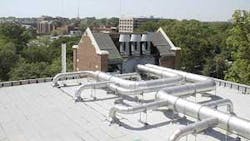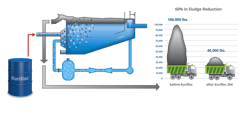Industrial Wastewater: Exhaust Odor Control with Mixed Flow Impeller Systems-Perception is Reality
It used to be discussing unpleasant odors emanating from chemical processing industry (CPI) facilities was like discussing the weather: Everyone talked about it, but no one did anything. There hasn’t been much progress toward influencing the weather, but a lot of progress has been made toward managing unpleasant odors.
While there are almost as many odors as there are chemicals being processed, there also are quite a few methods available to deal with them. One recently refined technology, though, hasn’t received as much recognition. That’s use of mixed flow impeller systems that dilute odiferous exhaust gases with ambient air above the roofline prior to discharge into the atmosphere. This dilution is done using low-profile roof exhaust fans. Dilution can effectively eliminate the perception of odor, which in many cases, is the only way to measure it. In other words, if an odor-annoying or not-is perceived, it’s considered an odor.
Since odor is based on perception, it’s sometimes hard to quantify its removal from an exhaust stream. Most odor control technologies such as wet scrubbing, bioscrubbing, thermal or catalytic oxidation, charcoal filtration, precipitation, or other exhaust treatment technologies can generally be quantified as to effectiveness. Manufacturers often can accurately predict the amount of chemical substances to be removed from an exhaust stream. On the other hand, when an odiferous exhaust stream is diluted with a mixed flow impeller roof exhaust fan, for example, there’s no accurate means of quantifying its odor-laden agents. Still, depending on the odor to be eliminated, this technology has proven quite effective since its capacity (in cubic feet per minute-cfm) can be precisely matched to meet a particular application.
Dilution solution
The theory of mixed flow impeller operation is simple: To control odor by dilution, fresh air is mixed with the chemical-laden exhaust air until a suitable concentration-ppm or mg/m3-is reached and the odor is no longer perceptible or objectionable. For example, consider an air stream with a 2-butanone (MEK) concentration of 900 mg/m3. The safe concentration of MEK for exposure to humans is 600 mg/m3. To render the MEK-laden air safe, it needs to be mixed in equal parts with fresh air to lower the concentration to 450 mg/m3. The odor threshold for MEK, however, is only 30 mg/m3-thus, to dilute the MEK to below detectable levels, 30 volumes of fresh air would have to be added.
Dilution also is used for analyzing an objectionable chemical odor. It works like this: A panel of judges with “better-than-average” noses is convened in a laboratory. A sample of the chemical-laden air is taken, introduced into tubes in random sequence and mixed (diluted) with increasing amounts of fresh air until the odor is either not objectionable or isn’t detectable by the judges when they sniff the tubes. This level of detectability of chemical odor determines the concentration allowed at the property line or at the intake of ventilation equipment. When comparing the concentration of the original sample with the concentration needed to avoid odor detection, a dilution level is calculated. For example, an exhaust containing chemical odors might need to be diluted 100:1, 1,000:1, or even more before being acceptable.
Dilution can be achieved directly by mixing exhaust air before it leaves the exhaust fan. Or, it can be achieved indirectly, where the stream of air discharged by the exhaust fan (the plume) is diluted by the atmosphere after it leaves the fan and before it reaches the property line or nearby air intakes, doors, windows, air conditioners or pedestrian walkways. Direct dilution methods used by mixed flow impeller fans operate on this principle. Fans draw odor-laden exhaust into a ductwork system and carry it to the highest point of the building’s roof. Fresh air is drawn into the exhaust fan to mix with and dilute the odiferous chemical exhaust, which is ejected from the exhaust fan upward at high velocity. This induces large amounts of air to be drawn into the plume, causing immediate relief of odor perception by dilution. Often use of such a system is enough to solve an odor problem on its own. If not, combining dilution with other available odor-control methods can be considered.
High velocity ejection
Wind tunnel studies have shown direct dilution is most effective when the diluted airstream is projected upward at velocities in excess of 3,000 ft/min. For comparison, a typical centrifugal-type fan used for the same application might require a steel stack as tall as 100 ft. to achieve the same results; this obviously isn’t practical. Even if it were, the cost and complexity of such a structure, and its unsightliness, work against it. Also, for retrofit situations where employees or neighbors have previously complained about odor, a tall stack (even 25 ft. high) can be a daily reminder of the presence of the odor-and the perception of pollution.
External factors
Several factors affect an exhaust plume’s characteristics in the environment. Many can’t be influenced by the system designer, such as the building’s shape, topography of surrounding terrain and meteorological conditions. The geometry-and location-of exhaust and supply fans are critical factors in the design of a safe, effective system. Wind is also a critical component. Not only does it influence direction and discharge of an exhaust plume, it also creates wake areas that can diminish plume height and, in some cases, trap it in these areas. This could lead to high concentrations of exhaust gases in these zones. Indoor air quality (IAQ) problems might also result if the building’s supply fans are located in these zones. IAQ problems, many of which are caused by re-entrainment of building exhaust through doors, windows, intake vents or other opening, can open up an entirely new can of worms for a building’s operators and/or owners
A typical mixed flow impeller installation on a building's roof.
A simple method of analyzing a building’s geometry is known as the “geometric method.” This technique is only applicable to rectangular buildings because this method doesn’t consider topography of the land surrounding the building. When you factor that in, models become more complex. Atmospheric stability, temperature gradient, and turbulence in the area also are important considerations. A strong, stable atmosphere creates a boundary layer or inversion that can keep the exhaust plume from penetrating the atmosphere or possibly send it right back toward the exhaust point. Topography of the terrain also will affect the gradient of the wind profile. For example, level rural areas will typically experience high winds at lower elevations than urban areas. Considerations such as ambient air temperature and humidity are other factors in odor control technology selection.
Chemical applications
While mixed flow impeller technology may be ideal for managing many chemical and/or wastewater process exhaust odors on a standalone basis, there will be other applications where certain pollutants cannot be dispersed effectively by dilution alone. In these instances certain chemicals such as potassium permanganate, sodium hypochlorite, chlorine or other substances might need to be added to the exhaust stream to help dilute and/or diminish the odor. This is especially true for wastewater odor control problems. For some of these applications chemicals, mixed flow impeller fans, and carbon and/or bio-scrubbers may be combined to treat odors typically emanating, for example, from a wastewater treatment pumping station. Considerations such as ambient air temperature and humidity come into play as well, as odors are perceived more easily under certain atmospheric conditions than others.
Other advantages
Mixed flow impeller fans are significantly shorter (about 15’ high) than the tall, often unsightly stacks used with conventional centrifugal fans. In addition, these low-profile fans don’t require structural reinforcements on the roof, nor complex, expensive mounting/stabilizing hardware such as elbows, flex connectors, guy wires or spring vibration isolators. Their simplicity can reduce installation time and costs substantially.
Since these fans consume about 25% less energy than conventional centrifugal fans, they offer faster payback as well. Typical energy reduction is $0.44 per cfm at $0.10/kilowatt-hour, providing about a two-year return on investment. In addition, lower noise levels, particularly in the lower octave bands, might be advantageous in some locations. When noise is still an issue, though, accessories such as acoustical fences and silencer nozzles can be used. Mixed flow impellers also conform to all applicable ANSI/AIHA Z9.5 laboratory ventilation guidelines, as well as to ASHRAE 100 standards and National Fire Protection Association 45 standards, and are UL 705-listed.
Dilution levels must vary depending on the specific chemical/odor contained in the exhaust airstream. For example, mercaptan and hydrogen sulfide emission-related odors (which smell like rotten eggs and are irritating even at extremely low concentrations), require substantially more dilution than less noxious chemicals such as butyl acetate, ethyl butyrate, octyl acetate, methyl salicylate, ethyl methanoate, and others as well. For example, chemical laboratory fume hood exhaust might have to be diluted as much as 5,000 times, while exhaust from diesel motors or emergency generators might require 10,000:1 dilution in order to eliminate odor perception-and neighbors’ complaints.
Conclusion
While use of mixed flow impeller technology may not be the ideal solution for all industrial wastewater odor control problems, it certainly has demonstrated its ability to solve many of them. The technology offers significant advantages over more traditional methods. When it’s acceptable, users can take advantage of low installation and operating costs, its ability to eliminate exhaust re-entrainment, significantly lower maintenance costs, and its low profile configuration to help meet building codes’ aesthetic requirements. With these advantages, and others described here, it would be prudent to learn more about this technology for your odor control problem.
About the Author:
Paul Tetley is vice president and general manager of Strobic Air Corp., a subsidiary of Met-Pro Corp., of Harleysville, Pa. Contact: 800-722-3267, [email protected] or www.choosetristack.com.
Technology System Characteristics
Mixed flow impeller systems operate on a unique principle of diluting contaminated exhaust air with unconditioned, outside ambient air via a bypass mixing plenum. The resulting diluted process air is accelerated through a discharge nozzle/windband where nearly twice as much additional fresh air is entrained into the exhaust plume before leaving the fan assembly. Additional fresh air is entrained into the exhaust plume after it leaves the fan assembly via a natural aspiration effect. The combination of added mass and high discharge velocity minimizes risk of contaminated exhaust being re-entrained into building fresh air intakes, doors, windows or other openings.
For example, a mixed flow fan moving 80,000 cfm of combined building and bypass air at an exit velocity of 6,300 feet per minute (fpm) can send an exhaust air jet plume up to 120 ft. high in a 10 mph crosswind. This extremely high velocity exceeds ANSI Z9.5 Standards by more than twice the minimum recommendation of 3000 fpm. With up to 170% of free outside air is induced into the exhaust airstream, a substantially greater airflow is possible for a given amount of exhaust. This provides excellent dilution capabilities and greater effective stack heights over conventional centrifugal fans without more horsepower.
Mixed flow impeller systems also reduce noise, use less energy and provide enhanced performance with faster payback over conventional centrifugal fan exhaust systems. Direct drive motor bearings have lifetimes of L10 400,000 hours.* Non-stall characteristics of the system’s mixed flow wheel make it ideally suited for constant volume or variable air volume (VAV) applications, along with built-in redundancy, and design flexibility. VAV capabilities are achieved via the bypass mixing plenum or by using variable frequency drives to provide optimum energy savings.
Minimal maintenance requirements (as there are no belts, elbows, flex connectors, or spring vibration isolators) eliminates the need for expensive penthouses to protect maintenance personnel under adverse conditions. Thus, additional savings of several hundreds of thousands of dollars may be realized in a typical installation.
A variety of accessories are available that add value, reduce noise, and/or lower energy costs. For example, heat exchanger glycol/water filled coils for use in 100% conditioned makeup air (controlled environment) facilities add exhaust heat to intake ventilation air to save thousands (or hundreds of thousands) of dollars in annual energy costs.
* NOTE: This refers to a “sample” of 100 motors in which the bearings in 10 motors (10%) would fail within a 400,000-hour timeframe. It’s a baseline for comparison of motor bearing lifetimes.


